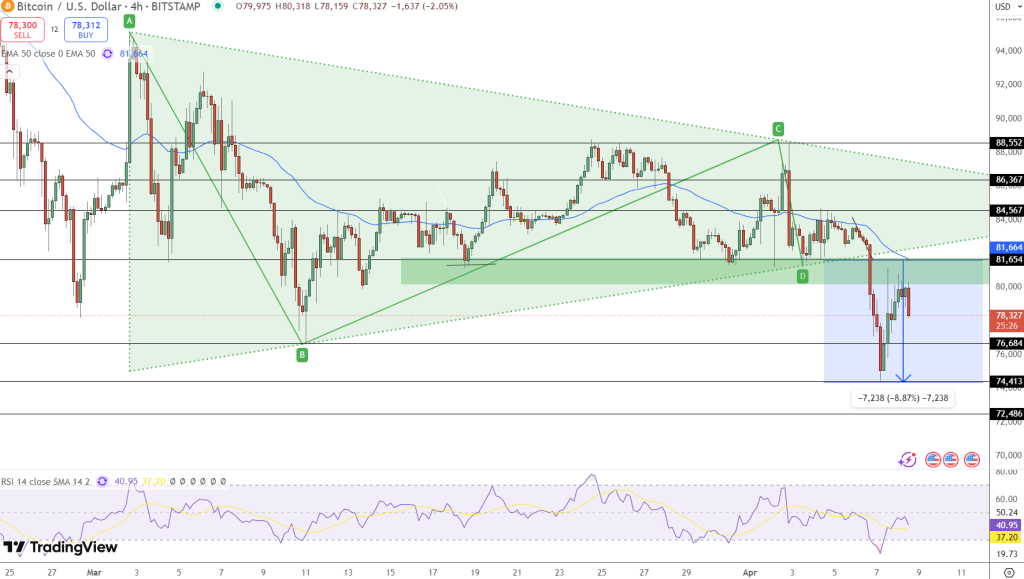Corporate Bitcoin Treasuries Take a Hit: What It Means for the Market
In an unexpected turn of events, corporate Bitcoin treasuries saw a staggering decline of nearly $4.5 billion in the first week of April, dropping from around $59 billion to just $54.5 billion between April 2 and April 7, as reported by BitcoinTreasuries.net. This drop comes amid escalating U.S.-China trade tensions, ignited by former President Trump’s alarming announcement of sweeping 50% tariffs on numerous Chinese imports. The ripple effects of these geopolitical tensions are proving to be significant, stirring reactions across various markets, including cryptocurrency.

What’s Driving the Current BTC Market Sentiment?
Currently, a total of 174 entities are reported to hold around 3.15 million BTC, with publicly listed firms comprising a significant portion of these holdings. However, the correlation between Bitcoin’s performance and the stock values of these firms has never been more pronounced; as Bitcoin dipped, so too did their share prices. For instance, the Bitwise Bitcoin Standard Corporations ETF (OWNB), which tracks businesses heavily invested in Bitcoin, experienced a decline exceeding 13% following the tariff announcement. Similarly, MicroStrategy—one of the largest corporate Bitcoin holders—saw its stock drop by over 13%, emphasizing the growing intertwining of cryptocurrency with traditional equities in the financial landscape.
#Bitcoin fell to a four-month low of $74,500 amid global market turmoil following US tariffs. Analysts warn of potential declines to $69,000 or $50,000 if support levels break. Corporate treasuries face losses. pic.twitter.com/rP8k0rwKWE— Marco Cavallo (@artcava) April 8, 2025
Why This Matters: The Bigger Picture
The drastic decline in corporate Bitcoin treasuries has reignited the conversation around Bitcoin’s role in corporate finance. Unlike traditional assets like U.S. Treasury Bills, Bitcoin’s notorious volatility challenges companies’ objectives for stability and capital preservation. David Krause, a finance professor at Marquette University, aptly pointed out, “Cryptocurrencies’ high volatility and uncertain regulation are misaligned with treasury goals of stability and capital preservation.” This growing skepticism raises pivotal questions: Is Bitcoin a reliable asset for corporate treasuries, or does its volatility make it a risky gamble?
Expert Opinions: Analysts Weigh In
Despite the immediate bearish sentiment, some analysts retain an optimistic viewpoint regarding Bitcoin’s future. For instance, Matrixport has drawn parallels to the 2015 Bitcoin market behavior, when the cryptocurrency initially nosedived after China’s yuan devaluation but subsequently rebounded vigorously. The current geopolitical climate, marked by heightened tensions and the devaluation of currencies, could position Bitcoin as a hedge against fiat currency risks once again.
Additionally, Binance has highlighted Bitcoin’s historical tendency to outperform during periods of geopolitical strife—especially when conventional financial markets are under duress. This insight suggests that, even in the face of present challenges, Bitcoin may yet find its footing as a viable investment.
Potential Broader Implications: Economic Uncertainty Looms
The ongoing tariff conflict extends beyond just the cryptocurrency market, shaking investor confidence across the board. Trump’s protectionist tariffs, including a striking 25% on pharmaceuticals and semiconductors, have sparked fears of a looming global trade war. In response, China has implemented retaliatory tariffs as high as 34% on U.S. goods, which has only compounded the uncertainty in global markets.
#China’s response to @realDonaldTrump additional 50% tariff threat? Let’s play. Moves to stabilize stock market with state funds as flagged in official media earlier this week.Central Huijin: https://t.co/US3YxiwCLHNFRA: https://t.co/HoIt9G9Q7mP— Eunice Yoon (@onlyyoontv) April 8, 2025
In light of these events, Bitcoin may serve as a hedge for some companies, providing a buffer against currency debasement and geopolitical risk. A recent report from Fidelity Digital Assets argues that Bitcoin can counterbalance these risks, which are particularly relevant in today’s financial landscape.
Technical Analysis: Bitcoin’s Market Movements
Currently, Bitcoin is trading around $78,300 after facing resistance near the $80,300 mark. The price remains capped below the 50 EMA at approximately $81,600, maintaining a bearish trend. The current support levels are set at:
- Initial Support: $76,600
- Critical Support: $74,400
Conversely, resistance levels are indicated at:
- Resistance Level 1: $81,600 (EMA)
- Resistance Level 2: $83,800 (previous high)
The RSI reading of 41 suggests that the bearish momentum is still intact, with Bitcoin not yet in oversold territory. A break below $76,600 could trigger a retest of $74,400, and until Bitcoin can decisively hold above $81,600, technical indicators continue to favor a downside trend.
Conclusion: Navigating the Crypto Landscape Amidst Uncertainty
As corporate Bitcoin treasuries grapple with unprecedented challenges, the implications stretch far and wide. Whether Bitcoin will reconcile its role in treasury management remains to be seen, but the current market landscape necessitates vigilance. What are your thoughts on the implications of these events for Bitcoin and corporate investments in it? Join the conversation and share your insights!
Introducing Best Wallet: The Future of Crypto Management
In the midst of this tumultuous market, innovative platforms are emerging to streamline crypto asset management. Best Wallet ($BEST) is redefining the user experience, combining security with practicality in a user-friendly wallet that supports over 1,000 cryptocurrencies. With cutting-edge technology like Fireblocks MPC-CMP, Best Wallet ensures your assets are secure.
A standout feature, “Upcoming Tokens,” allows users early access to promising presale tokens—giving investors a competitive edge as new assets enter the market. With the recent presale surpassing $11.5 million, Best Wallet is earning trust and interest.
With estimated annual rewards of 137%, it’s no surprise that market confidence in Best Wallet’s innovative solutions is growing. For the latest updates, be sure to follow Best Wallet on X and Telegram!

